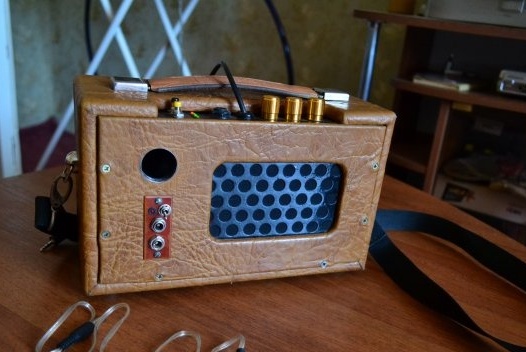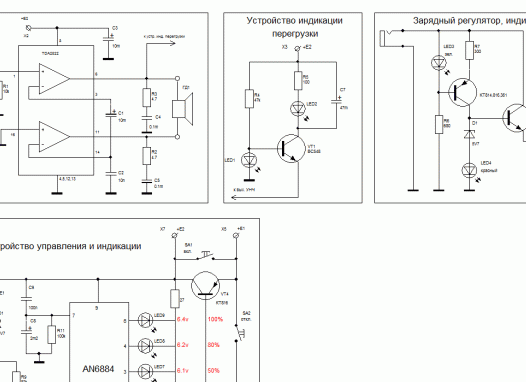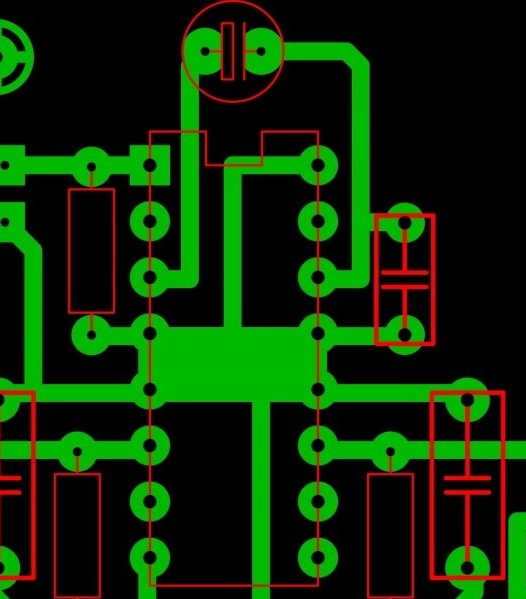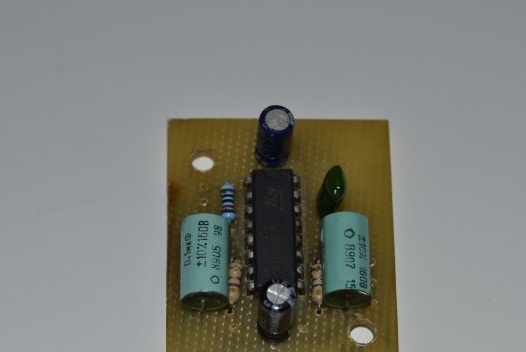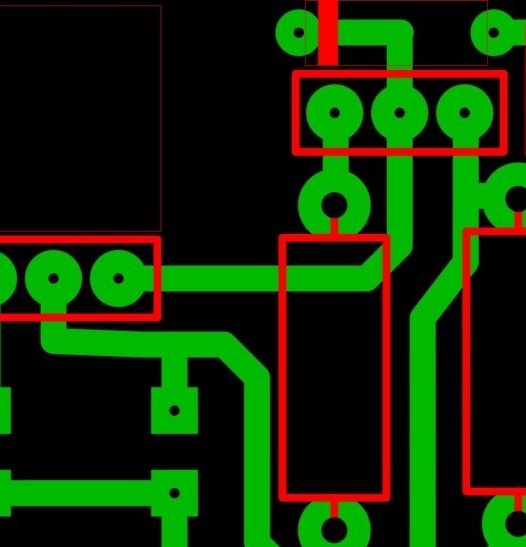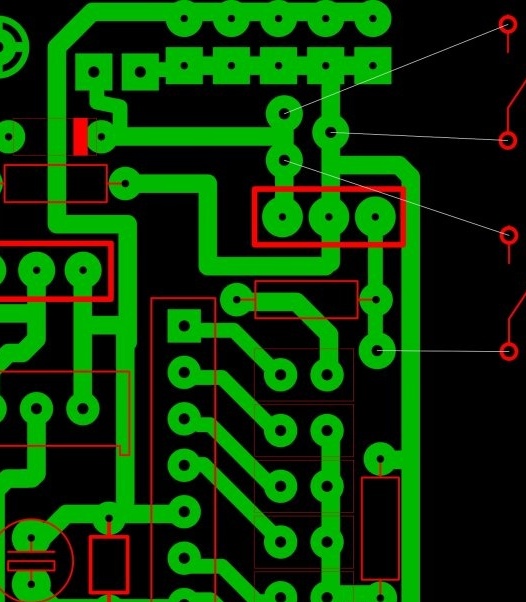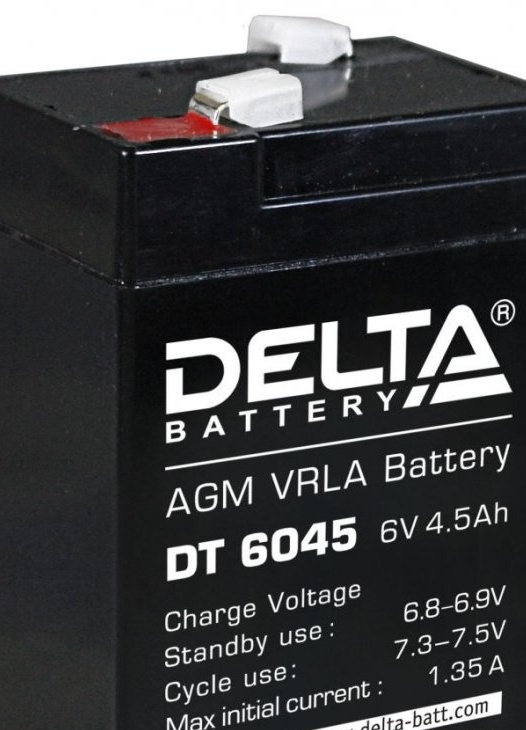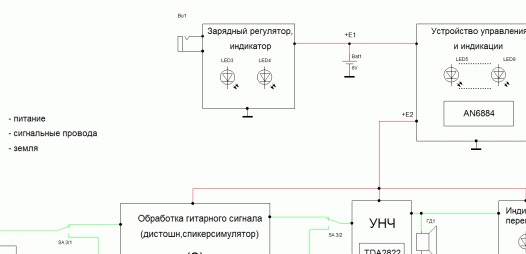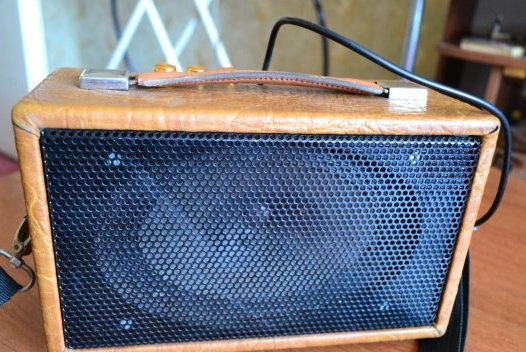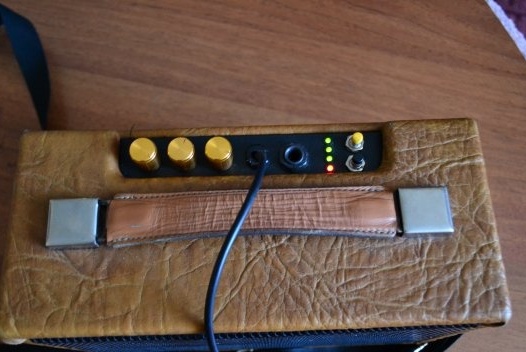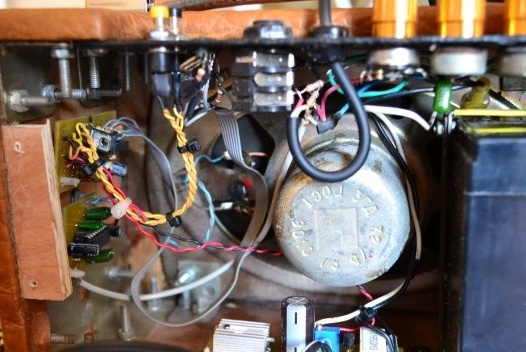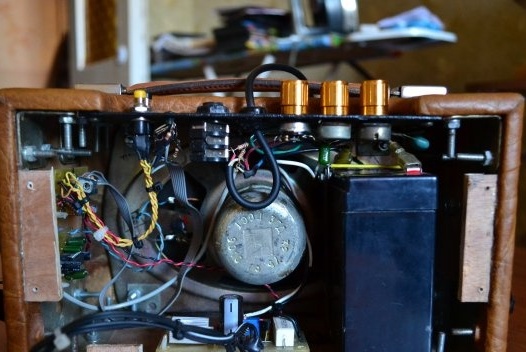Once upon a time I had the idea to make a portable speaker for listening to music, but with the ability to connect a guitar. Yes, now it’s not uncommon to meet a teenager with screaming irresponsible music in a small box, and portable combos are easily bought through the Internet. Also, due to the spread of modular design and the availability of these same modules on aliexpress, an incredible amount of home-made products of all kinds was created. But then ... then everything was different. The presence of such a toy caused bewilderment among passers-by and delight in the company. Accordingly, with some help from friends of radio amateurs, the development of his own representative began. The goal was a portable system with the smallest possible consumption and good sound. Also, the battery should act as power so as not to spend money on batteries constantly. The result is this:
The general scheme, divided into blocks for convenience, you can observe below.
In fairness, I want to note that the column has been lost for a long time and this article is more likely a memorial in memory and a demonstration of how we did it 10-15 years ago.
ULF block
As an amplifier, the TDA2822 chip was chosen. It is noteworthy that it is better to use a chip with 16 pins, and not with 8. With the same consumption, it provides significantly better sound. The chip was designed specifically for portable systems and systems with low consumption, it is not uncommon to stumble upon it in cheap Chinese USB speakers.
A typical bridge connection. With a supply voltage of 6V and a load resistance of 4 ohms, the microcircuit is capable of delivering 0.65 watts per channel, that is, in a bridge connection we get about 1.3 watts, which is quite enough. Believe me, in the end, the unit screams in such a way that if you turn it on at full volume, then talking on a street five meters from it is not very comfortable. A big plus is the fact that the chip does not require any additional cooling, a radiator is not needed. Such amplifiers, in spite of their moral obsolescence, I collect for various projects to this day. They have good characteristics and sound definitely better than cheap Chinese D-class modules for 10 rubles.
Charging regulator, indicator.
Everything is quite simple here.The voltage taken from the emitter of the transistor VT3 is set by the Zener diode D1 and LED4. If the zener diode has a stabilization voltage of 5.7 V, then the red LED should be chosen such that the voltage sagged on it is 1.6-1.7 volts. As a result, at the output of the circuit, we should get 7.3-7.4 volts. I always set to 7.35V, strive for this value. LED3 - green. Moreover, it is desirable to use LEDs for indication, those that shine dimly and are matte. And it should be exactly green, not light green or with a yellow tint. Then this LED will indicate the end of the battery charge and at the end of its charge will glow brightly, while with a discharged battery it will dim or will not glow at all.
It is worth noting that the VT3 transistor must be installed on the radiator. I collected this charger, it is tested and working. But due to certain circumstances, later I collected and used another charger.
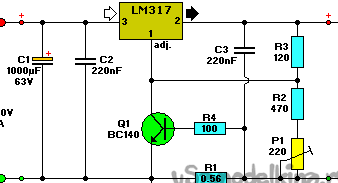
The description is taken from a third-party resource, I have nothing to add.
The circuit shown above is a conventional current regulator, to which a current limiter consisting of Q1, R1, and R4 is added. When the current becomes too large, the transistor Q1 opens, thereby causing a decrease in the output voltage.
The output voltage is 1.2x (P1 + R2 + R3) / R3 V. The current limit is activated when the current reaches 0.6 / R1 A. For a 6-volt battery requiring fast charging, the charge voltage is 3x2.45 = 7.35 V (3 2.45 V cells per cell). Thus, the total resistance R2 + P1 should be 585 ohms. For a 12-volt battery, the value of R2 + P1 is 1290 ohms.
In order for the circuit to work efficiently, the input voltage must be at least 3 V higher than the output voltage.
P1 is a standard trim resistor of suitable power.
The LM317 chip should be well cooled by a large heatsink.
The output voltage is 1.2x (P1 + R2 + R3) / R3 V. The current limit is activated when the current reaches 0.6 / R1 A. For a 6-volt battery requiring fast charging, the charge voltage is 3x2.45 = 7.35 V (3 2.45 V cells per cell). Thus, the total resistance R2 + P1 should be 585 ohms. For a 12-volt battery, the value of R2 + P1 is 1290 ohms.
In order for the circuit to work efficiently, the input voltage must be at least 3 V higher than the output voltage.
P1 is a standard trim resistor of suitable power.
The LM317 chip should be well cooled by a large heatsink.
Instead of the BC140 transistor, I used 2N2222. I enclose a circuit board below, keep in mind that this circuit board is designed for the LM to lie on the textolite and a radiator will be installed on top. If you want to do as usual - just mirror the print vertically. On the back of the device there is a socket for a power supply, which can be used as any unit capable of delivering from 10.3 volts. The unit for lotions on 12V is great. But keep in mind that for charging it is better to use exactly the unit with which you tuned the stabilizer. The voltage at the output of the stabilizer, albeit not significantly, but may vary depending on the voltage supplied to its input.
Control and indication device.
This is probably the most interesting and difficult part of this device. This unit implements the ability to indicate the battery charge, as well as protecting the latter from deep discharge. The same circuit protects the device from short-circuit, you never know what rain will have to get with it. The circuit is implemented on a linear indicator AN6884 and a transistor key. You can of course just do the assembly on the comparators. Switching the device on and off is performed by the buttons SA1 and SA2. Buttons should be without locking, to short circuit. Zener diode D1 is set to "zero point", the voltage which the microcircuit will consider the lower threshold. It will have to be picked up, since it is difficult to find zener diodes with such a face value on sale. The stabilization voltage should be in the range of 5.7-5.8 volts, but not lower than 5.7V. The divider R9 / R10 allows you to further set the threshold. As it was, I used a multi-turn 1k trimmer.
Resistor R8 should be chosen so that the circuit consumption is the smallest. Transistor VT4 acts as the most common key, it can be replaced with any similar one. Better yet, use a fieldman instead, well, of course, in this case you have to adjust the circuit a bit.
Resistor R8 should be chosen so that the circuit consumption is the smallest. Transistor VT4 acts as the most common key, it can be replaced with any similar one. Better yet, use a fieldman instead, well, of course, in this case you have to adjust the circuit a bit.
Now a little nuance. 27 ohm resistors are worth increasing. Personally, I set 1.5k. Perhaps it makes sense to put a resistor on each LED separately, especially if you use LEDs in different colors.I don’t remember how I did it at home. The goal is to achieve an indication, not a glow, we are not collecting a flashlight. Our device is portable, we have nothing to spend on LEDs for. Until I increased the resistance of these resistors, this unit consumed 120 mA, almost like the amplifier itself, you see, recklessness is complete. Now only 35 mA. Strive for this value.
Overload Indication Device
Unfortunately, this part was never implemented, because the circuit needs to be configured specifically for the microcircuit, for which an oscilloscope is needed. There wasn’t one then, the idea was discarded.
Nutrition.
As I said at the beginning, the circuit is designed to work with a 6V lead-acid battery. It is not difficult to get these batteries on the market; they are often used in Chinese portable radio / flashlights, etc. There are different capacities, I came across 4.5 and 6 Amp hours. Better of course to take a larger capacity.
I did not calculate how long the charge of such a battery would last, but I would say that up to 40 hours was enough at medium volume. Charges all night, while you should not be afraid for it, lead batteries do not be afraid of overcharging at set charge voltage, while a deep discharge is very afraid. It is enough to bring it to the last one, as the efficiency decreases by 30%, the second time - by 50%, the third - 70%, you can throw it away. Therefore, always make sure that your battery is charged, I have already changed 2 by stupidity.
Here's how to switch blocks:
As a signal processing unit, I have the usual passive timbral block assembled according to the classical Baksandal scheme, to which I added a signal level control.
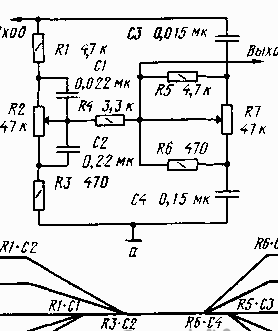
It is worth noting that the outputs from the phones / players are stereo, so the left and right channels should be connected through 1k resistors. Do the same with the connection of the guitar signal and the signal from the player, if you intend to use them simultaneously. After that, you already start the signal on the tone block. Keep in mind that such a timbral block can land a signal. On the back of the device, I added an additional power connector, to which I connect the “pizzotpyty zoom”, and play through it. You can’t imagine a better application for it.
Here is one of the devices. Collected for myself. Previously, my emblem was on the grill, but then it came off. I collected more than 2 years ago, already beaten by this life) In total, about 5-6 such devices were assembled for my memory, they all work properly and delight their owners.
The case of the tenth plywood, made of the old radio Leningrad 002. There was practically nothing to do, the case of this radio itself was made of plywood boards, all that was needed was to cut them into the necessary pieces. The front wall along with the speaker are taken from there. The speaker, by the way, is very good in it (3GD-32). Some sources say that this is the best broadband speaker produced in the USSR. I cut the back cover out of fifth plywood. The grate was torn from the TV found in the forest, though I had to fight for a long time with her friend XD
And so it turned out, the case was already ready at that moment, and the grill was exactly in place, sometimes it was lucky) I pulled the handle from an old suitcase and took it to the shoemaker to sheathe leather. The case itself is glued with the so-called "vinyl skin", in general they release special material for these purposes, but in home conditions, it is replaced by the skin of a young dermantine, which is bought in fabric stores under the guise of fabric for covering the kitchen corners. There are many options, you can choose for every taste and color.
The case of the tenth plywood, made of the old radio Leningrad 002. There was practically nothing to do, the case of this radio itself was made of plywood boards, all that was needed was to cut them into the necessary pieces. The front wall along with the speaker are taken from there. The speaker, by the way, is very good in it (3GD-32). Some sources say that this is the best broadband speaker produced in the USSR. I cut the back cover out of fifth plywood. The grate was torn from the TV found in the forest, though I had to fight for a long time with her friend XD
And so it turned out, the case was already ready at that moment, and the grill was exactly in place, sometimes it was lucky) I pulled the handle from an old suitcase and took it to the shoemaker to sheathe leather. The case itself is glued with the so-called "vinyl skin", in general they release special material for these purposes, but in home conditions, it is replaced by the skin of a young dermantine, which is bought in fabric stores under the guise of fabric for covering the kitchen corners. There are many options, you can choose for every taste and color.
On the back wall there is a charging socket, a charging indicator, a socket for connecting external devices (in my case, a processor), a container for a processor power cord and a completely unnecessary toggle switch. He stuck the grille so that the speaker system was open, as it sounds so much better to me. The grill itself protects the insides from mechanical damage, and the fabric is pasted to protect it from dust.
Well, from above, I think everything is clear power buttons, tone block knobs. LEDs indicate battery power.
Interior. Not very neat, but considering how many times I redid it ...
Question about transportation.
If someone decides to do something like that, great advice to you. At first, when the device was just made, it was thought to carry it by the handle. But over time, it became clear how much it is not convenient. First, annoying to drag it in his hand. I generally hate carrying something in my hands. Secondly, because of the battery, the device has a fairly large weight for its size, mine weighs about 3 kg, it would seem not much, but if you walk for a long time - your hands get tired.
Therefore, it was decided to equip it with a belt so that it could be worn over the shoulder. The belt on the carabiners, so you can remove it if you wish. Keep this in mind when you think through the case. I just ordered two such screws with a specific hat from a turner.
Therefore, it was decided to equip it with a belt so that it could be worn over the shoulder. The belt on the carabiners, so you can remove it if you wish. Keep this in mind when you think through the case. I just ordered two such screws with a specific hat from a turner.
In general, somehow we assembled portable speakers 10-15 years ago) Of course, now a lot of this is no longer relevant, lead has long been replaced by cheaper, lighter and more capacious Li-ion batteries, charging and discharge control modules are sold at bargain prices , and the "standard" for portable systems has become a wireless connection via A2DP. At the same time, I think the article is a good demonstration that this can also be done from the components available from the components, which can be obtained from the old (everything is relatively finite), unnecessary equipment.
Printed circuit boards, circuits, datasheets can be downloaded in one archive below.
Download

